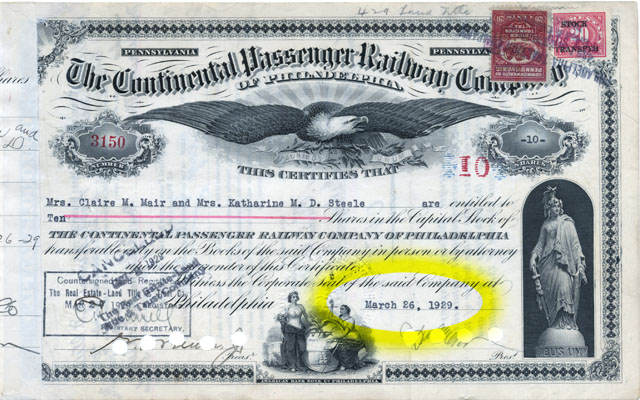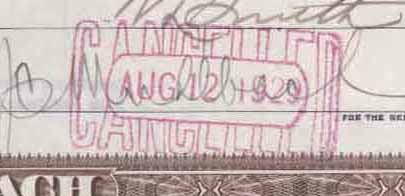Dates on certificates
Several kinds of dates can appear on securities. Although there are common placements of the various dates, there are no specific rules that cover the entirety of collectible certificates. The most common dates that collectors will encounter include:
- Date of issuance (generally the most important for collectors)
- Date of registration
- Date of cancellation
- Date of transference
- Date of redemption
Issuance dates on stock certificates

Dates can appear practically anywhere on the fronts of stock certificates, although they generally appear in the bottom right quadrant, usually in the last couple lines of text. The majority of certificates issued during the 20th century also show dates near left borders where clerks at companies tasked with registering certificates signed their names.
It is not unusual for railroad companies to have issued several different printings of stock certificates with what initially appears to be identical designs. Describing minor variations between near-identical issuances can be difficult. In many cases, the easiest way to spot variations if to look at the printed portions of dates.
By themselves, I consider variations in pre-printed dates to be extremely minor and I did not initially record them. It turned out, however, that pre-printed dates are frequently the fastest way to spot less obvious, but more important variations.
Issuance dates on bond certificates
It is possible to describe practically all bonds by whether they were:
Holders of bearer bonds could receive principal and interest payments, regardless of how the
- registered to specific investors or companies or
- bearer bonds that could be sold or redeemed by whomever held them.
The dates on most registered bonds are similar to stock certificates and are normally found near the bottom of bonds in the last one or two lines of text. Those dates represent the exact date that bonds were issued.

Conversely, bearer bonds generally represent the first date that the whole bond issue was issued, NOT necessarily the precise day that individual bonds were issued. Some very early bearer bonds were, in fact, issued on the day specified and dates were often handwritten. After about 1870, almost all bearer bonds (of the same issuance) display a single uniform date. Like everything else in the hobby, there are exceptions. Most bearer bonds display dates in the last one or two lines of printed text in the bottom right corners of certificates like the example below.

Issuance dates on other certificates
With only rare exception, dates on certificates of deposit, temporary stocks and bonds, transfer receipts and all other kinds of security-related certificates listed on this site follow the same rules as stocks. The majority of dates on those certificates are found somewhere in the bottom half although dates can appear anywhere. There are no hard and fast rules.
Registration dates on stock certificates
Many 20th century stock certificates display a registration date,. aligned vertically, just inside of the left border. The date of registration may or may not be the same day the stock was issued, but it is usually within a day or two. I have not corresponded with anyone who cared about registration dates although I have found them occasionally useful for establishing the year a certificate was issued. Examining registration dates is sometimes necessary when issuance dates are cancelled or rendered illegible by bad handwriting or ink smears.

Redemption dates on bonds
Again, with rare exception, bonds promised to repay borrowed funds on specific dates, even if those dates were one hundred or more years in the future. Because repayment is always more important to investors than promised interest income, redemption dates are usually reported in the first few lines of text on bonds. Redemption dates are normally written in text form like the example below.

Redemption dates on equipment trust certificates
In practice, modern Equipment Trust Certificates (ETCs) fill a hybrid role between stocks and bonds. They are designed to buy equipment that they then lease to specific railroads. If an equipment trust raises $15,000,000 to buy equipment, it sells 15,000 "shares" to investors in units of $1,000 each. Investors then own partial interest in equipment as opposed to interest in companies. Like bonds, ETCs pay money to investors every six months to repay them for the risk they are taking, but the money comes from equipment lease payments as opposed to profits from providing transportation.
While it might seem like a distinction without a difference, those semi-annual payments are called dividends as opposed to interest. Unlike bonds, ETCs repay groups of investors over time as opposed to repaying all investors all at once. Equipment trusts are normally designed to last 15 years, or roughly the lifespan of railroad rolling stock. Over that period, a typical equipment trust would make 60 dividend payments. Consequently, equipment trusts retire their certificates on that same schedule. If a trust issued 15,000 ETCs, then it would cash out 1/60th of its certificates every six months. This type of repayment is called a "serial" redemption as opposed to a "lump sum" repayment. In this example, the trust would retire 250 certificates every six months.

ETCs strongly resemble bonds and there are normally spots on each certificate reserved for recording redemption dates. All certificates of the same issue look identical except for the redemption date added during issuance.
Although each modern equipment trust would have issued certificates with 60 different redemption dates, this project lumps them all under one variety listing. It is possible that some collectors might try to collect all sixty redemption dates of specific issues, but I have never encountered such a collector. Therefore, I do not burden the database with so many minor possibilities. Below is an example of a specific redemption date from an equipment trust certificate. (See more about Equipment Trust Certificates elsewhere on this website.)

Cancellation dates on all types of certificates
Dates of cancellation are normally important only when they reflect days of historical importance (i.e. bombing of Pearl Harbor, 1929 Crash of Wall Street, VE day, etc.) Small numbers of specialists also appreciate cancellation dates important to specific company events or days in the lives of certificate owners. A small number of certificates are dated within cancellation stamps as in the example below.

Collectors are warned that amateur eBay sellers unfamiliar with the scripophily hobby sometimes quote redemption dates instead of issuance dates. If either date is important to you, be sure to confirm with sellers before buying.